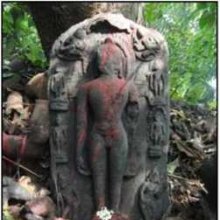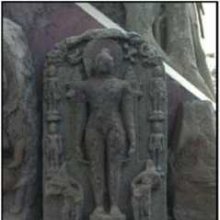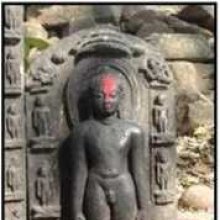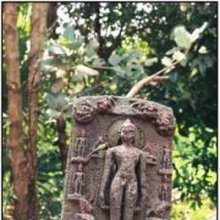Tirthika, Tīrthika: 12 definitions
Introduction:
Tirthika means something in Buddhism, Pali, Hinduism, Sanskrit, the history of ancient India. If you want to know the exact meaning, history, etymology or English translation of this term then check out the descriptions on this page. Add your comment or reference to a book if you want to contribute to this summary article.
Images (photo gallery)
(+11 more images available)
In Hinduism
Shaivism (Shaiva philosophy)
Source: DSpace at Pondicherry: Siddha Cult in Tamilnadu (shaivism)Tīrthika (तीर्थिक).—Another group of Siddhas that existed during the 10th and 11th centuries was known as Tīrthika Siddhas. They became celebrated for their extraordinary knowledge; fond of debates and display of their knowledge among the public or in the royal courts.
The tīrthikas were distinguished by certain symbols like umbrellas. It is said that once a tīrthika-paṇḍita from the South India was honoured with five umbrellas for challenging Dipaṅkara (C.E. 982-1054), who was celebrated for his scholarship not only among the contemporary Buddhists and others.

Shaiva (शैव, śaiva) or Shaivism (śaivism) represents a tradition of Hinduism worshiping Shiva as the supreme being. Closely related to Shaktism, Shaiva literature includes a range of scriptures, including Tantras, while the root of this tradition may be traced back to the ancient Vedas.
Kavya (poetry)
Source: archive.org: Naisadhacarita of SriharsaTīrthika (तीर्थिक) or Tairthika refers to a “follower of a religion or a sect”, and is mentioned in the Naiṣadha-carita 17.50, 103.—In 17.50 the Cārvāka addresses the adherents of the orthodox faith as Tīrthika. In 17.103 the orthodox faith is characterised by one of its defenders as the Tīrthika way, i.e., the traditional path. [...] Pt. Śivadatta points out in a footnote in his edition that ṭhaka [?] will give the form Tairthika, [...] Generally speaking, the word is used by non-Brahmanical writers to denote the followers of the Brahmanical religion. In [the Naiṣadhacarita] it is put into the mouth of a Cārvāka, and if a protagonist of the orthodox faith also uses it, he does so while replying to the Cārvāka.
Similarly, the Buddhists use the word in the form Tīrthikā to denote the followers of other sects, especially of the Brahmanical religion. Laṅkāvatārasūtra uses the words Tīrthya and Tīrthakara in a similar sense. [...] The Buddhists thus use the words Tīrthika, Tīrthya and Tīrthakara to signify the adherents o f non-Buddhist, especially Brahmanical, schools of thought, as distinguished from the members of their own faith, the Svayūthyas, as they are called in the Bodhicaryāvatārapañjikā.
The Jainas use the word Tīrthika in a similar sense, e.g., in Upamitibhavaprapañcā-kathā, p. 51; in Jinaprabha’s Pārśvanāthastava (verse 14); in Dhanapāla’s Ṛṣabhapañcāśikā; and in Hemacandra’s Mahāvīrastotra (verses 4 and 20).
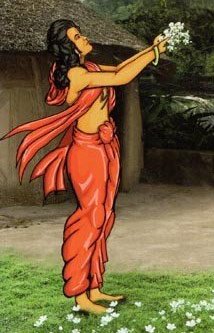
Kavya (काव्य, kavya) refers to Sanskrit poetry, a popular ancient Indian tradition of literature. There have been many Sanskrit poets over the ages, hailing from ancient India and beyond. This topic includes mahakavya, or ‘epic poetry’ and natya, or ‘dramatic poetry’.
In Buddhism
Mahayana (major branch of Buddhism)
Source: Wisdom Library: Maha Prajnaparamita SastraTīrthika (तीर्थिक) refers to “heretics”, according to Mahāprajñāpāramitāśāstra (chapter 8).—Accordingly, “[Question: How does the Bodhisattva fulfill the virtue of meditation (dhyānapāramitā)?]—[Answer]—When he obtains mastery (vaśita) over all the dhyānas of the heretics (tīrthika). Thus king Śaṅkhācārya, seated in meditation, had no in- (āna) or out- (apāna) breath. A bird came and laid her eggs in his top-knot which was in the form of a conch (śaṅkhaśikhā); the Bodhisattva remained motionless (acala) until the fledglings flew away”.
Source: Kunpal: Shantideva's Bodhisattva-charyavataraTīrthika (तीर्थिक).—The Sanskrit word tīrthika is often translated as ‘heretic’, but tīrthika in fact refers to someone who is on a path other than the Buddhist one.
According to Khenpo Chöga’s Oral Explanations on text section 163: “The Buddha has surpassed all the paths of the tīrthikas. Even when the tīrthikas reach the peak of worldly existence, they can never go beyond the confines of worldly existence [srid pa]. The great masters of the tīrthika systems can reach saṃsāra’s peak but never go beyond that point because they have not realized the wisdom of egolessness. Tīrthika masters can temporarily overcome gross afflictions, but they never attain the wisdom of egolessness. Tīrthika meditation masters at best take rebrith in the subtle spheres of the realms of formlessness [gzugs med khams].”
Source: academia.edu: A Study and Translation of the GaganagañjaparipṛcchāTīrthika (तीर्थिक) refers to “heretics”, according to the Gaganagañjaparipṛcchā: the eighth chapter of the Mahāsaṃnipāta (a collection of Mahāyāna Buddhist Sūtras).—Accordingly, as the Lord said to the Bodhisattva Maitreya: “O Maitreya, I entrust you with this [teaching of] incomparable complete awakening, which has been established for countless hundreds of millions of aeons, in order that it will be memorized, understood, read, and elucidated in detail to others, in order to give thanks and gratitude to the Tathāgata, fulfill my aspirations, increase and purify many beings’ roots of good, make the Bodhisattvas attain the light of the dharma, subjugate all Māras, defeat all heretics (tīrthika), uphold the dharma of the highest meaning, and in order not to break the lineage of the three jewels”.

Mahayana (महायान, mahāyāna) is a major branch of Buddhism focusing on the path of a Bodhisattva (spiritual aspirants/ enlightened beings). Extant literature is vast and primarely composed in the Sanskrit language. There are many sūtras of which some of the earliest are the various Prajñāpāramitā sūtras.
India history and geography
Source: Cologne Digital Sanskrit Dictionaries: Indian Epigraphical GlossaryTīrthika.—(EI 9), Buddhist; teacher of a religion other than one's own; a non-Buddhist (especially, Śaiva) teacher. (EI 32), same as Tairthika, ‘a priest’. Note: tīrthika is defined in the “Indian epigraphical glossary” as it can be found on ancient inscriptions commonly written in Sanskrit, Prakrit or Dravidian languages.

The history of India traces the identification of countries, villages, towns and other regions of India, as well as mythology, zoology, royal dynasties, rulers, tribes, local festivities and traditions and regional languages. Ancient India enjoyed religious freedom and encourages the path of Dharma, a concept common to Buddhism, Hinduism, and Jainism.
Languages of India and abroad
Sanskrit dictionary
Source: DDSA: The practical Sanskrit-English dictionaryTīrthika (तीर्थिक).—
1) A pilgrim, an ascetic Brāhmaṇa (visiting holy places).
2) An adherent or head of any other than one's own creed; Buddha, Jaina.
Derivable forms: tīrthikaḥ (तीर्थिकः).
Source: Cologne Digital Sanskrit Dictionaries: Edgerton Buddhist Hybrid Sanskrit DictionaryTīrthika (तीर्थिक).—(also para-t°; see prec. and next items; probably Sktized from MIndic (Pali) titthiya, see tīrthya; both are very common in prose as well as verses), (1) heretic; like its relatives, pejoratively used; there is one seeming exception, tīrthikā vā bhavanti bhavasūdanāḥ Mahāvastu i.106.8 (verse), where if the text is correct it seems to be said of Bodhisattvas in the 8th bhūmi that they become religious prophets (or the like), destroying (the states of normal) existence. I suspect a corruption, and cannot explain the text as it stands any more than Senart (his doubtful suggestion based on Lalitavistara Calcutta (see LV.) 313.19 falls now with the reading of that text, which in Lefm. 250.1 is replaced by…tīrthyāḥ, heretics, kurvante). However, it is barely possible that this one Mahāvastu passage preserves the original neutral meaning, adherent (or founder) of (any) religion. A trace of this may also remain in the not infrequent pre- fixation of anya- to t°, other (than Buddhist) sectarian, Lalitavistara 268.12; Mahāvastu iii.49.12 (anyatīrthikapūrvo, formerly a member of another sect); 412.7; or para-t°, q.v.; compare kutīr- thikā(ḥ) Lalitavistara 12.10, members of base (heretical) sects. Other- wise, and very often, tīrthika alone means heretic simply: Saddharmapuṇḍarīka 272.10; Lalitavistara 250.21; 258.1; 260.9; Mahāvastu i.45.10; 69.17; ii.135.12; iii.392.7 (śramaṇa-brāhmaṇa-tīrthika-gaṇikā, apparently implying that brahmans were not included among tīrthikas; this [compound] appears in some of the other passages listed); Mahāvyutpatti 3514; Divyāvadāna 146.19; 152.5; 275.9; Avadāna-śataka i.2.6; 16.3 etc., common; Bhadracarī 52; Bodhisattvabhūmi 173.11 etc.; [Page255-a+ 71] yat kiṃcit tīrthikaliṅgaṃ…Lalitavistara 409.17; Mahāvastu iii.329.11, whatever (external) mark (dress etc.) of heretics (was borne by converts, all magically disappeared and they wore the aspect of Buddhist monks); tīrthikāvakrāntaka, see avakrāntaka; (2) name of a nāga: Mahāvyutpatti 3320; (3) see s.v. sama-tīrthika.
Source: Cologne Digital Sanskrit Dictionaries: Monier-Williams Sanskrit-English DictionaryTīrthika (तीर्थिक):—[from tīrthaka > tīra] m. an adherent or head of any other than one’s own creed, [Buddhist literature; Jaina literature]
Source: DDSA: Paia-sadda-mahannavo; a comprehensive Prakrit Hindi dictionary (S)Tīrthika (तीर्थिक) in the Sanskrit language is related to the Prakrit words: Utthiya, Titthia.
[Sanskrit to German]
Sanskrit, also spelled संस्कृतम् (saṃskṛtam), is an ancient language of India commonly seen as the grandmother of the Indo-European language family (even English!). Closely allied with Prakrit and Pali, Sanskrit is more exhaustive in both grammar and terms and has the most extensive collection of literature in the world, greatly surpassing its sister-languages Greek and Latin.
See also (Relevant definitions)
Starts with: Tirthikadharma, Tirthikajnana, Tirthikaparishad, Tirthikaparivrajaka, Tirthikar, Tirthikara, Tirthikarana, Tirthikarshi, Tirthikashila.
Ends with: Amratirthika, Anyatirthika, Ashvatirthika, Dharmatirthika, Pancatirthika, Paratirthika, Samatirthika, Tritirthika.
Full-text (+15): Paratirthika, Tirthya, Anyatirthika, Tirthakara, Tairthika, Tirthaka, Titthia, Shankara, Tirthikadharma, Utthiya, Tirtha, Shvayuthya, Tirthikashila, Suvimuktaprajna, Parivrajaka, Marakarman, Kusumayudha, Dhyanaparamita, Pancayudha, Vasita.
Relevant text
Search found 21 books and stories containing Tirthika, Tīrthika; (plurals include: Tirthikas, Tīrthikas). You can also click to the full overview containing English textual excerpts. Below are direct links for the most relevant articles:
Jain Remains of Ancient Bengal (by Shubha Majumder)
Pañca-tīrthika type of Candraprabha sculptures < [Chapter 6 - Iconographic Study of Jaina Sculptural Remains]
Pañca-tirthika type of Śāntinātha Sculptures < [Chapter 6 - Iconographic Study of Jaina Sculptural Remains]
Images of Tīrthaṅkara Dharmanātha < [Chapter 6 - Iconographic Study of Jaina Sculptural Remains]
Bodhisattvacharyavatara (by Andreas Kretschmar)
Text Section 163 < [Khenpo Chöga’s Oral Explanations]
Text Section 68 < [Khenpo Chöga’s Oral Explanations]
Text Section 91 < [Khenpo Chöga’s Oral Explanations]
Mahayana Mahaparinirvana Sutra
Chapter XX - On Holy Actions (b) < [Section Three]
Chapter X - On the Four Truths < [Section One]
Chapter XIII - On Letters < [Section Two]
Maha Prajnaparamita Sastra (by Gelongma Karma Migme Chödrön)
Mahāyāna auxiliaries (E): The five powers < [Part 3 - The auxiliaries according to the Mahāyāna]
Appendix 9 - Identification of the Dharma teacher ‘Kao Tso’ < [Chapter XIV - Emission of rays]
Part 8 - Why is the Buddha called Anuttara < [Chapter IV - Explanation of the Word Bhagavat]
Abhidharmakośa (by Leo M. Pruden)
Vakyapadiya of Bhartrihari (by K. A. Subramania Iyer)
Verse 3.6.25 < [Book 3 - Pada-kāṇḍa (6): Dik-samuddeśa (On Position)]
